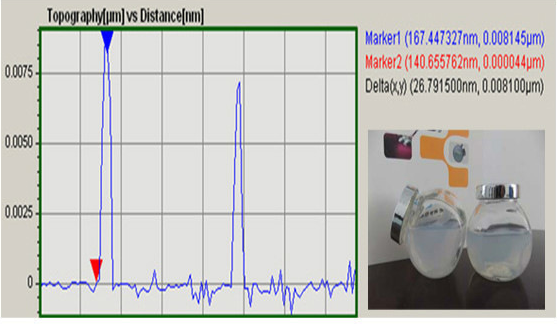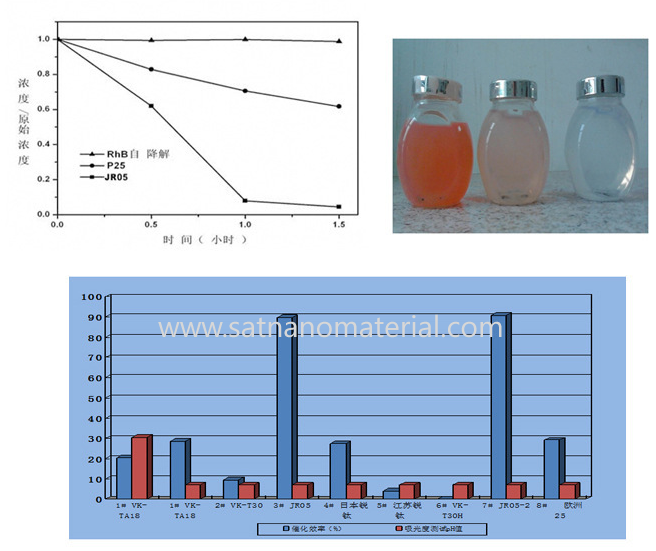A photocatalyst is also called photocatalysis. Simply, a photocatalytic material undergoes light irradiation and does not change itself but can promote other substances to undergo a chemical reaction. There are many examples of photocatalyst reactions around us. The most typical is The chlorophyll, which plays the most important role in photosynthesis of plants, is a photocatalyst.
Photocatalysts will produce photocatalytic reactions similar to photosynthesis under the irradiation of light, producing free hydroxyl and active oxygen with strong oxidation ability. They have a strong photoredox function and can oxidize and decompose various organic compounds and parts. Inorganic substances, which can damage the cell membrane of bacteria and proteins that solidify the virus, can kill bacteria and break down organic pollutants. Quickly decompose formaldehyde, benzene and ammonia in the air into non-toxic and harmless carbon dioxide and water. The main component of the photocatalytic material is nano-scale titanium dioxide.
The indoor high-activity nano-titanium dioxide photocatalyst produced by our company extends from 200-380 nanometers (ultraviolet light) to 400-700 nanometers (visible light). Puzzles for indoor applications.

2: The figure below shows the degradation curve of SAT NANO titanium dioxide and German P25 on rhodamine B under simulated sunlight. It can be seen from the figure that SAT NANO titanium dioxide has good photocatalytic activity. Under simulated sunlight, Complete degradation of pollutants can be achieved in about 1 hour. Under the same conditions, German P25 only degrades about 30%!

3: It can effectively remove harmful gases such as formaldehyde!
SAT NANO nano photocatalyst breaks through the international problem that “photocatalytic materials can only be activated by ultraviolet light”, it extends from 200-380nm (ultraviolet) to 400-700nm (visible light), which greatly improves the photocatalysis of nano titanium dioxide. effectiveness.
4: It has super strong antibacterial, deodorizing and deodorizing capabilities!
Photocatalyst antibacterial principle: After being exposed to visible light, photocatalysts generate a large number of active superoxide ion and hydroxyl radicals. They can easily penetrate the cell wall of bacteria, destroy the cell membrane, enter the bacteria, prevent the transmission of film-forming substances, and prevent Disconnect its respiratory system and electronic transmission system, thereby effectively killing bacteria. The bactericidal rate of SAT NANO photocatalyst antibacterial agent is more than 99.98%, and it can kill more than 600 kinds of bacteria such as Staphylococcus, E. coli, Aspergillus niger and so on. Widely used in hospitals, schools, food factories, homes.
Photocatalysts will produce photocatalytic reactions similar to photosynthesis under the irradiation of light, producing free hydroxyl and active oxygen with strong oxidation ability. They have a strong photoredox function and can oxidize and decompose various organic compounds and parts. Inorganic substances, which can damage the cell membrane of bacteria and proteins that solidify the virus, can kill bacteria and break down organic pollutants. Quickly decompose formaldehyde, benzene and ammonia in the air into non-toxic and harmless carbon dioxide and water. The main component of the photocatalytic material is nano-scale titanium dioxide.
The indoor high-activity nano-titanium dioxide photocatalyst produced by our company extends from 200-380 nanometers (ultraviolet light) to 400-700 nanometers (visible light). Puzzles for indoor applications.
What are the advantages of nano photocatalysts?
1: The particle size is 5 nanometers, uniform without precipitation, large specific surface area and strong adhesion.
The particle size is 5 nanometers, uniform without precipitation, large specific surface area, and strong adhesion. The preparation of anatase-type titanium dioxide into 5 nanometers of photocatalyst powder is a miracle in itself. Our company is able to mass produce 5nm photocatalyst powders internationally Manufacturers with an annual production capacity of 200 tons.
The particle size is 5 nanometers, uniform without precipitation, large specific surface area, and strong adhesion. The preparation of anatase-type titanium dioxide into 5 nanometers of photocatalyst powder is a miracle in itself. Our company is able to mass produce 5nm photocatalyst powders internationally Manufacturers with an annual production capacity of 200 tons.

2: The figure below shows the degradation curve of SAT NANO titanium dioxide and German P25 on rhodamine B under simulated sunlight. It can be seen from the figure that SAT NANO titanium dioxide has good photocatalytic activity. Under simulated sunlight, Complete degradation of pollutants can be achieved in about 1 hour. Under the same conditions, German P25 only degrades about 30%!

3: It can effectively remove harmful gases such as formaldehyde!
SAT NANO nano photocatalyst breaks through the international problem that “photocatalytic materials can only be activated by ultraviolet light”, it extends from 200-380nm (ultraviolet) to 400-700nm (visible light), which greatly improves the photocatalysis of nano titanium dioxide. effectiveness.
Testing for pollutants
|
Action time
|
Test result
|
Removal rate(%)
| |
Blank test chamber concentration value
(mg/m3)
|
Sample test chamber concentration value
(mg/m3)
| |||
benzene
|
24h
|
0.971
|
0.099
|
89.8
|
ammonia
|
24h
|
2.34
|
0.22
|
90.4
|
TVOC
|
24
|
5.65
|
0.357
|
93.7
|
4: It has super strong antibacterial, deodorizing and deodorizing capabilities!
Photocatalyst antibacterial principle: After being exposed to visible light, photocatalysts generate a large number of active superoxide ion and hydroxyl radicals. They can easily penetrate the cell wall of bacteria, destroy the cell membrane, enter the bacteria, prevent the transmission of film-forming substances, and prevent Disconnect its respiratory system and electronic transmission system, thereby effectively killing bacteria. The bactericidal rate of SAT NANO photocatalyst antibacterial agent is more than 99.98%, and it can kill more than 600 kinds of bacteria such as Staphylococcus, E. coli, Aspergillus niger and so on. Widely used in hospitals, schools, food factories, homes.
Test microorganism
|
Total number of colonies in the control sample "0" contact time (cfu / ml)
|
Total number of standard control samples after shaking for 24H (cfu / ml)
|
The total number of colonies in the test sample after shaking for 24H (cfu / ml)
|
Antibacterial rate (%)
|
(Escherichia coli) ATCC 25922
|
2.3x10^4
|
1.4x10^7
|
1.6x10^5
|
98.86
|
(Staphylococcus Aureus)
|
1.9x10^4
|
7.9x10^4
|
6.8x10^3
|
95.19
|
Our company SAT NANO can supply Nano Photocatalyst TiO2 used for Antibacterial and Antivirus, please contact our sales at admin@satnano.com for the detailes.
评论
发表评论